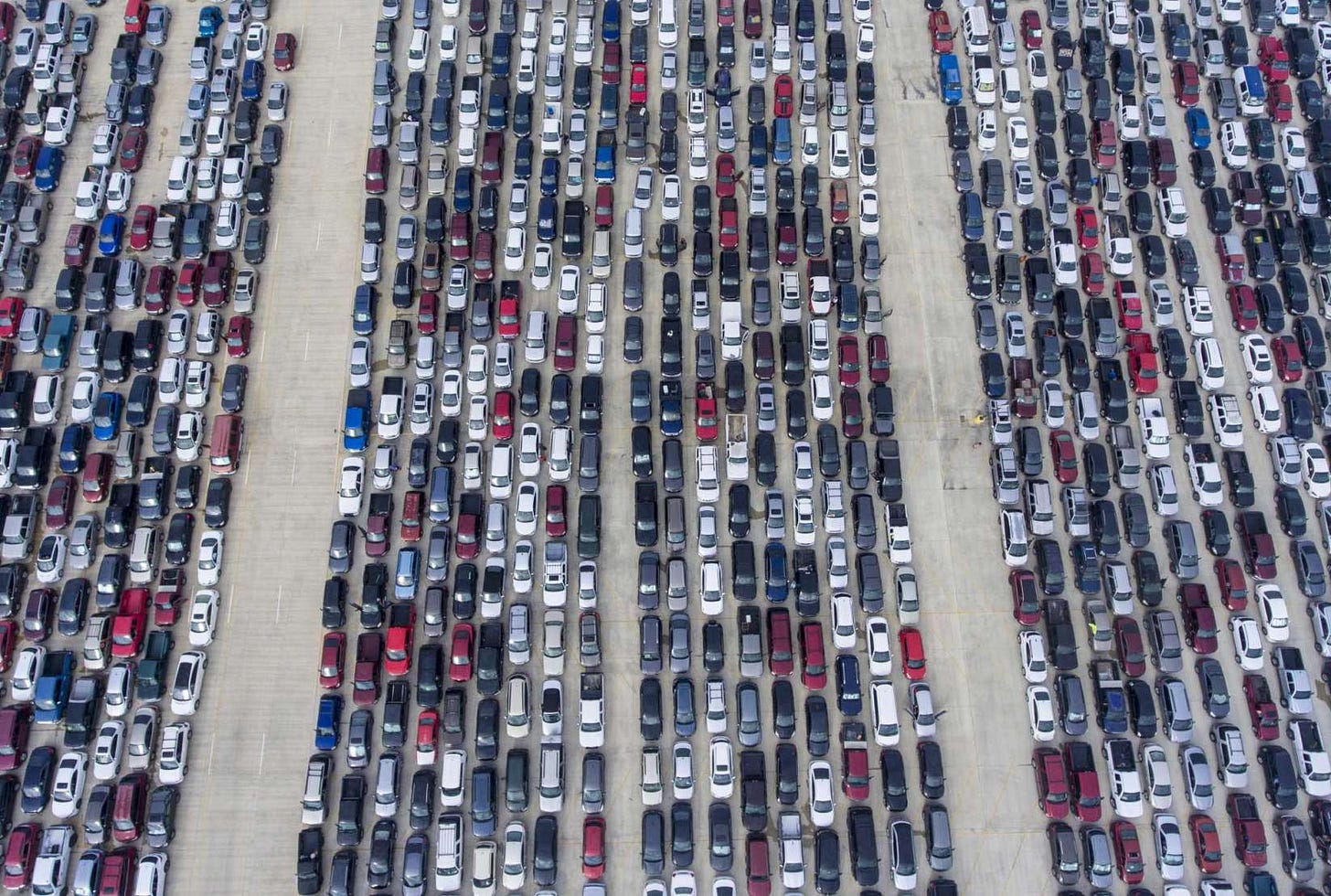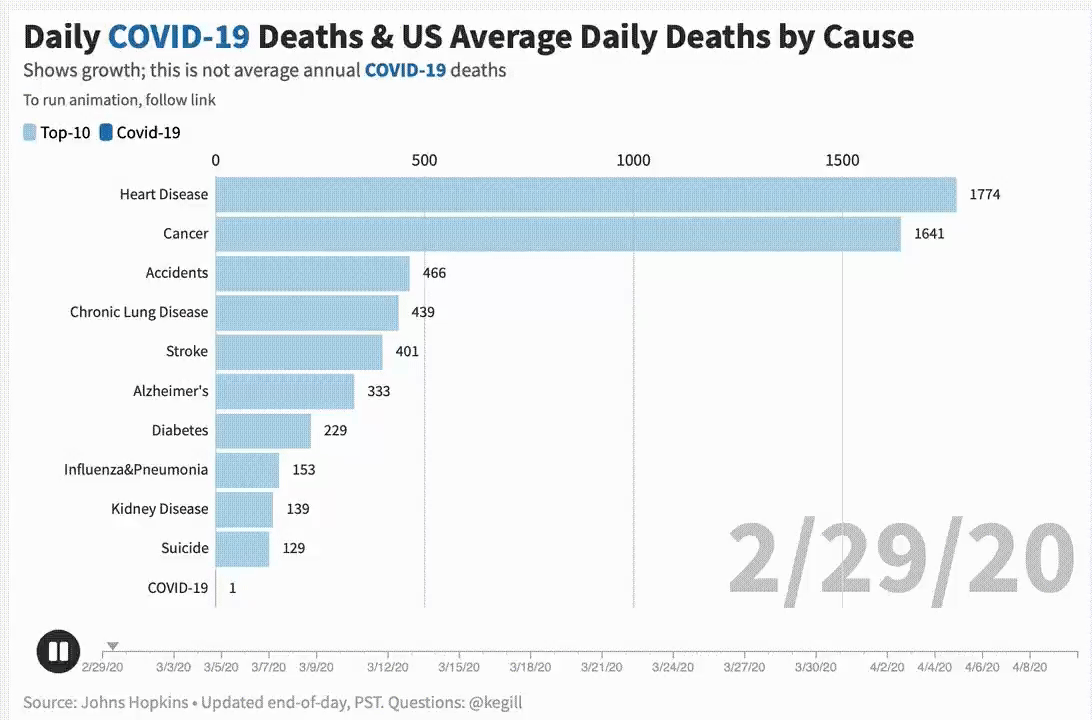COVID-19 day 81 : 📈 501,609 cases; 18,777 deaths : 10 April 2020
San Antonio food bank fed ~10K households on Thursday; MD is conducting its primary via mail ballots, GA postponed its primary a second time; global deaths exceed 100,000

It’s day 81 since the first case of coronavirus disease was announced in the United States. And in San Antonio, about 10,000 households turned for help at the local food bank’s drive-through distribution system. Thursday was “the largest single-day distribution in the nonprofit’s 40-year history.”
Cars started lining up before dawn. By 6 a.m., the parking lot was full.
The San Antonio Express reported that 6.6 million people have applied for first time unemployment benefits.
This is the “Kathy is tired” edition.
France has reported 43 cases of “heart incidents” linked to the use of hydroxychloroquine with coronavirus patient treatment.
Although media repeatedly reference it as a “malaria” drug, it would be more accurately labeled an “anti-rheumatic” drug or as a treatment for arthritis or lupus. Because in the US, only about 2,000 cases of malaria are diagnosed each year.
On the other hand, an estimated 1.5 million Americans have some form of lupus.
Rheumatoid arthritis, an auto-immune disorder, affects about 1.3 million Americans.
And hydroxychloroquine is a recognized treatment for both of these chronic (ie, they don’t ever “go away”) diseases. Yet there is a global shortage. And a key ingredient is “skyrocketing” in price.
After Trump initially touted the drug in mid-March, Dr. Alfred Kim, a rheumatologist in St. Louis, told CNN that “the entire local supply was depleted” within days.
“If we don’t take steps to mitigate the shortage, we all will face the real possibility of running out of these drugs in the next few weeks," a spokesperson for Kaiser Permanente said in a statement to KATU News on Friday.
Friday, Johns Hopkins reported 501,609 (466,033) cases and 18,777 (16,690) deaths in the US, an increase of 7.6% and 12.5%, respectively, since Thursday.
That case rate is 151.54 per 100,000; the death rate is 56.73 per million.
One week ago, the case rate was xx per 100,000, and the death rate, xx per million.
🤓Recommended reading
How important is “silent spreading” in the covid-19 epidemic?The Economist, 11 April edition.
You Should Worry About Coronavirus in the South—Just Not for the Narrow-Minded Reasons You’re Sharing. Mother Jones, 02 April 2020.
💃🏼Life hack
About masks: we need testing.
[R]esearch suggests that COVID-19 can spread via invisible droplets as small as 5 microns and by tiny bioaerosol particles as well as via visible respiratory droplets just by breathing…. The extent of any protection will depend on how the masks are made and used [emphasis added].
This University of Massachusetts study (2016) focused on comparing mask types for protection against smog and air pollution. Cloth did not win.
Researchers worry that wearing a cloth mask lends a false sense of protection.
🌐Global news:
Financial Times /New Straits Times / New York Times / South China Morning Post / The Age / The Globe and Mail / The Guardian / Wall Street Journal / Washington Post // CIDRAP / STAT News // ProPublica / The Atlantic / The Conversation / The Economist // ABC News (Australia) / ABC News (US) / BBC News / CBC / CBS News / CNBC / CNN / C-SPAN / NBC News
⓵ Around the country
All 50 states, the District of Columbia, Guam, the Northern Mariana Islands, Puerto Rico and the US Virgin Islands have identified COVID-19 cases. The only state with no reported deaths is Wyoming, yet they have 340 identified cases. Arkansas has 246 cases and seven deaths.


More attention needs to be directed at America’s food manufacturing system, which relies on low wages in poultry and meat packing facilities, for example. And yes, there are coronavirus outbreaks at meat packing plants. The worry is not that you or I would catch the disease. The worry is that the facilities could shut down.
In 2018, we spent about 10% of our personal income on food, divided about 50-50 between food at home and food away from home. Shortages at processing food plants will drive up the price of groceries.
Drone footage of workers in haz mat suits burying wooden coffins flooded Twitter today. Here’s the backstory on New York’s potter’s field, Hart Island, which is east of the Bronx. Over the years, it has “served as a Civil War prison camp, a Cold War missile storage site, a drug rehab facility.”


I’d not thought about burials and cemeteries and potter’s fields in major cities until today.
Under the new policy, the city Medical Examiner’s Office said it will now hold bodies in storage for 14 days before they are shipped out for burial if they remain unclaimed.

⓶ Around the world
The number of affected countries/territories/areas jumped from 29 at the end of February to 207 today (no additions). Although early reports tied the outbreak to a seafood (“wet”) market in Wuhan, China, analyses of genomic data suggest that the virus may have developed elsewhere.
Lifting restrictions too quickly can lead to a rebound: Tedros Adhanom Ghebreyesus, PhD, the WHO's director-general
"The way down can be as dangerous as the way up if not managed properly," he said, noting that key factors include controlled transmission, access to medical services, minimized risk to settings such as nursing homes, prevention measures at workplaces and other essential locations, and management of imported infection risks.
On Friday, Italy extended its national lockdown until 03 May.
As goes the US, there goes Australia with a “recent rise in anti-Chinese sentiment.”

⓷ Politics, economics and COVID-19
A collaboration between governors, health care leaders, former government officials, and tech leaders is leading to a plan to deal with coronavirus, but there are no guarantees that the White House or Congress will follow along.
[Their strategy] relies on the three pillars of disease control: Ramp up testing to identify people who are infected. Find everyone they interact with by deploying contact tracing on a scale America has never attempted before. And focus restrictions more narrowly on the infected and their contacts so the rest of society doesn’t have to stay in permanent lockdown.
Reading this, I feel like I’ve inhabited the movie Groundhog Day. How many times before now have I seen “the three pillows of disease control” outlined, explained, promoted? I cannot keep count.
Axios keeps a running primary news update, including postponements. Maryland is conducting its postponed primary via mail ballots. Georgia has postponed its presidential primary a second time, from 19 May to 09 June.
⓸ Case count
There is a lag between being contagious and showing symptoms, between having a test and getting its results. The virus was not created in a lab.
🌎 10 April
Globally: 1 521 252 confirmed (85 054 - new) with 92 798 deaths (7,277 - new)
The Americas: 493 173 confirmed (38 463 - new) with 17 038 deaths (2,264 - new)
Johns Hopkins interactive dashboard (11.40 pm Pacific)
Global confirmed: 1,699,019 (1,602,216)
Total deaths: 102,774 (95,735)
Total recovered: 376,734 (355,079)
🇺🇸 10 April
CDC: 459,165 (427,460) cases and 16,570 (14,696) deaths
Johns Hopkins*: 501,609 (466,033) cases and 18,777 (16,690) deaths
State data*: xx (460,048) identified cases and xx (16,535) deaths
View infographic and data online: total cases, cases/100,000 and deaths/million.
* Johns Hopkins data, 11.40 pm Pacific.
State data include DC, Guam, the Northern Mariana Islands, Puerto Rico and the US Virgin Islands
See US (state/territory) total cases, cases/100,000 and deaths/million as infographics.

⓹ What you can do
Stay home as much as possible, period.
Digestive problems may be a symptom.
Resources
👓 See COVID-19 resource collection at WiredPen.
📝 Subscribe to Kathy’s Daily Memo :: Daily Memo archives
🦠 COVID-19 @ WiredPen.com



